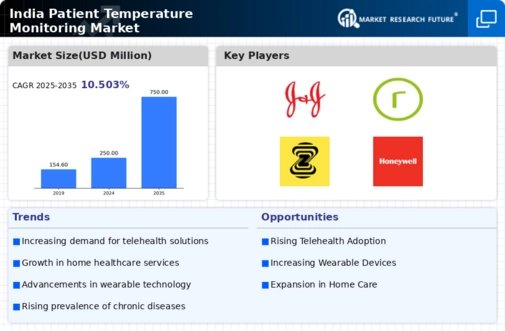Growth of Home Healthcare Services
The expansion of home healthcare services in India is significantly influencing the patient temperature-monitoring market. As more patients prefer receiving care at home, the demand for portable and user-friendly temperature-monitoring devices is increasing. The home healthcare market is projected to grow at a CAGR of around 20% over the next few years, driven by factors such as an aging population and a shift towards personalized care. This trend suggests that temperature-monitoring devices will become essential tools for caregivers and family members, enabling them to track patients' health conditions effectively. Consequently, the patient temperature-monitoring market is likely to benefit from this shift, as manufacturers develop innovative solutions tailored for home use.
Rising Demand for Preventive Healthcare
The increasing emphasis on preventive healthcare in India is a notable driver for the patient temperature-monitoring market. As awareness of health issues grows, individuals are more inclined to monitor their health proactively. This trend is reflected in the rising sales of personal health monitoring devices, which have seen a growth rate of approximately 15% annually. The patient temperature-monitoring market stands to benefit from this shift, as consumers seek reliable and accurate devices to track their body temperature regularly. Additionally, healthcare providers are likely to promote temperature monitoring as part of routine health assessments, further driving demand in the market.
Technological Integration in Healthcare
The integration of advanced technologies in healthcare is a pivotal driver for the patient temperature-monitoring market. Innovations such as telemedicine, mobile health applications, and IoT-enabled devices are transforming how temperature monitoring is conducted. In India, the adoption of telehealth services has surged, with a reported increase of over 30% in usage among healthcare providers. This technological shift not only enhances the accuracy of temperature readings but also facilitates real-time data sharing between patients and healthcare professionals. As a result, the patient temperature-monitoring market is likely to experience growth, as stakeholders seek to leverage these technologies to improve patient outcomes and streamline healthcare delivery.
Increasing Prevalence of Chronic Diseases
The rising incidence of chronic diseases in India is a crucial driver for the patient temperature-monitoring market. Conditions such as diabetes, cardiovascular diseases, and respiratory disorders necessitate regular monitoring of vital signs, including body temperature. According to health reports, chronic diseases account for approximately 60% of all deaths in India, highlighting the need for effective monitoring solutions. This trend is likely to propel the demand for advanced temperature-monitoring devices, as healthcare providers seek to enhance patient care and outcomes. Furthermore, the integration of temperature monitoring into chronic disease management programs is expected to foster growth in the patient temperature-monitoring market, as it allows for timely interventions and better management of patient health.
Government Initiatives for Healthcare Improvement
Government initiatives aimed at improving healthcare infrastructure in India are significantly impacting the patient temperature-monitoring market. Programs focused on enhancing access to healthcare services, particularly in rural areas, are driving the demand for reliable temperature-monitoring solutions. The Indian government has allocated substantial funding to healthcare projects, with an emphasis on technology adoption and patient monitoring systems. This support is expected to create opportunities for manufacturers in the patient temperature-monitoring market, as they align their products with government standards and requirements. Furthermore, the push for digital health solutions is likely to encourage innovation and investment in temperature-monitoring technologies.















Leave a Comment